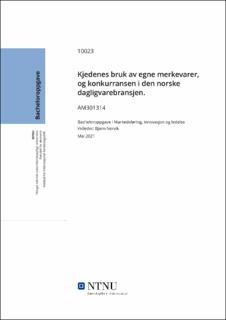| dc.contributor.advisor | Nervik, Bjørn. | |
| dc.contributor.author | Sandblåst, Henrik. | |
| dc.date.accessioned | 2021-09-14T17:05:34Z | |
| dc.date.available | 2021-09-14T17:05:34Z | |
| dc.date.issued | 2021 | |
| dc.identifier | no.ntnu:inspera:82450651:82454220 | |
| dc.identifier.uri | https://hdl.handle.net/11250/2776902 | |
| dc.description.abstract | Temaet for bacheloroppgaven er basert på de tre store handelshusene; Coop, NorgesGruppen og Reitangruppen. Og deres kjeder sin bruk av egne merkevarer (emv) i den norske dagligvarebransjen. Kjedenes store satsing på emv byr på utfordringer for de mange merkevareleverandørene. I denne oppgaven har jeg valgt å se på hvordan kjedenes egne merkevarer påvirker konkurransen i det norske dagligvaremarkedet. Oppgaven er skrevet fra kjedenes perspektiv, med et innblikk fra leverandørsiden av bransjen, og har følgende problemstilling:
” Hvordan opplever aktørene i den norske dagligvarebransjen at kjedenes egne merkevarer påvirker konkurransen.”
Kjedene har de siste tiårene hatt en økende satsning på emv-produkter, flere produkter på markedet gir økt konkurranse i markedet og kjedenes emv-satsning bidrar til å gi kjedene større makt i bransjen. Dette har gitt utfordringer for leverandørene.
Denne oppgavens teoretiske rammeverk skiller mellom temaene egne merkevarer, konkurranse og makt, og tar for seg Michael Porters femkraftsmodell og Kumar og Steenkamps inndeling av ulike former for emv for å besvare problemstillingen i oppgaven. I oppgaven har det blitt benyttet en kvalitativ metode, med dybdeintervjuer fra informanter med ulike stillinger i den norske dagligvarebransjen. Det har blitt intervjuet informanter fra ulike handelshus og kjeder i bransjen, i tillegg til en informant fra leverandør siden av markedet.
Flere produkter i de ulike kategoriene på markedet betyr økt konkurranse, og emv bidrar til å sette press på leverandørene og øker konkurransen mellom kjedene. Når kjedene begynte med emv-produkter var målet å konkurrere på pris i forhold til konkurrentene. I dag opererer kjedene med ulike emv-merkevarer og produktserier på alle prisnivåer og kvaliteter, og fokuset til kjedene er rettet mot innovasjon, kvalitetsprodukter og forbrukertrender. Kjedene fokuserer mye på innovasjon, og ønsker med dette å skape unike butikkonsept der målet er at forbrukerne skal foretrekke deres butikkonsept. | |
| dc.description.abstract | The theme of this Bachelor Thesis is based on the three major Norwegian grocery wholesale organizations: Coop, NorgesGruppen and Reitangruppen. And their chains` use of in-house brands in the Norwegian food industry. The umbrella chains´ large investment in in-house brands creates challenges and consequences for the many Norwegian suppliers and producers. In this thesis, I have chosen to study how the in-house brands affect the different organizations within the Norwegian food industry, and how the in-house brands affect the competition within the industry. This thesis is based on the chains` perspective, with an insight from the supplier side of the market. The thesis has the following research question:
” How do the organizations in the Norwegian food industry experience that the umbrella chains` own brands effect the competition”
The Norwegian grocery wholesales organizations have in recent decades had an increasing focus on in-house brands, more products on the market makes for a higher competition in the industry, and the chain`s increased investments on in-house brands contributes to increase the umbrella chain`s power over their competitors and suppliers in the market. This has posed challenges for Norwegian food market suppliers.
The thesis` theoretical framework distinguishes between the themes; in-house brands, competition and power. This thesis addresses Michael Porter`s five forces model, as well as Kumar and Steenkamp`s division of different forms of in-house brands. These theories will help give answers to the thesis research question. A qualitative method has been used in the thesis, with in-depth interviews from informants with different positions in the Norwegian food business, in addition to an informant from the supplier side of the market.
Increased number of products in the various categories in the market means increased competition, and in-house brands puts pressure on the suppliers. Additionaly it raises the competition level between the chains. When the chains started with in-house brands, the goal was to better compete on price compared to the competitors. Today, the chains operate with various in-house brands and product series at all price levels and qualities. The focus of the umbrella chains is on innovation, quality of products and consumer trends. The chains focus a lot on innovation and the chains want to create unique store concepts where the goal is for the consumers to prefer their store concept. | |
| dc.language | nob | |
| dc.publisher | NTNU | |
| dc.title | Kjedenes bruk av egne merkevarer, og konkurransen i den norske dagligvarebransjen. | |
| dc.type | Bachelor thesis | |
